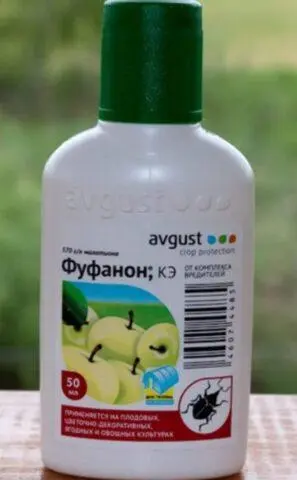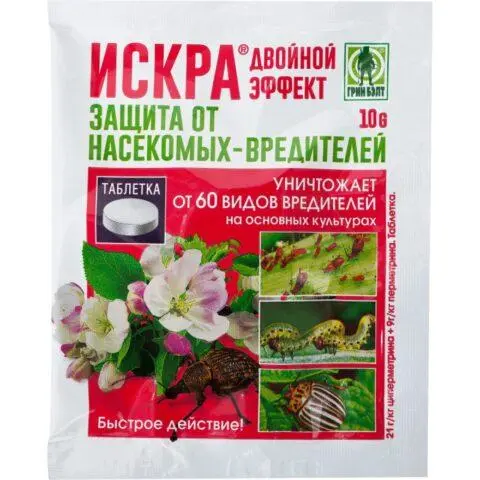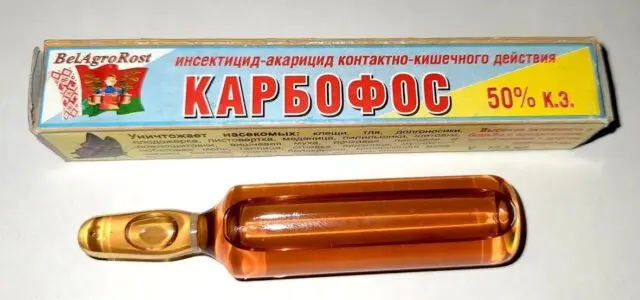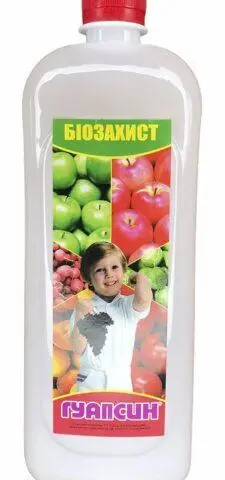Contents
Raspberries are a common fruit shrub that many gardeners prefer to grow on their plots. After all, its delicious fragrant fruits are liked not only by adults, but also by children, and healing jam based on them helps to treat colds and coughs. To get a good harvest of raspberries, you need to follow the basic rules of care. They include pest control, one of which is the raspberry beetle. This insect damages the leaves and fruits of the shrub. And if you do not introduce a fight with it, then you can not count on the high productivity of raspberries.

Raspberry beetle can destroy 30-50% of the crop
What does a raspberry beetle look like
This pest is small in size. The body length of the raspberry beetle (Byturus tomentosus) does not exceed 4 mm. The color is dark gray or brown, and in the region of the abdomen on the edges of the pronotum, the shade is reddish. The raspberry beetle has three pairs of legs, and on the head there are club-shaped antennae, consisting of 11 segments.
The eggs of the pest are elliptical, up to 1 mm in size, white or yellowish. The larva is worm-like, having three pairs of thoracic legs. The length of her body reaches 6-6,5 mm. The color of the larva is light brown or yellowish. The body is covered with short light hairs. Transverse dark spots are visible on the back. And at the end of the body, the larva has two hook-shaped spikes bent upwards. The pupa of the crimson beetle is white, 3-4 mm long.
Signs of damage to the bushes
Initially, the pest feeds on young raspberry leaves. When damaged, holes appear on the plates between the veins of the second order. In the future, you can find other characteristic signs of the vital activity of brown beetles on raspberries.
Small, ugly-shaped berries grow from partially damaged flowers by the pest, and the fruits in which the larvae have settled become dull, wither and rot.
What harm does
Raspberry beetles eat not only raspberries, but also feed on nectar and anthers of currant, cherry, gooseberry, apple, pear, plum, and bird cherry flowers. If you do not fight this pest in the garden, then the yield of all fruit bushes and trees decreases.
The raspberry beetle hibernates in the soil next to raspberries at a depth of 10 cm. At the end of April, when the air temperature warms up to +12 ° C, the raspberry beetle begins its active years. Initially, adults feed on young raspberry leaves and weeds. And after full recovery of strength after winter, the mating process begins in the raspberry beetle. Pest females lay eggs in raspberry buds one by one between pistils and stamens. And by the time the ovary is formed, larvae appear from them. Initially, they spend three days outside the fruit, and then bite into the berries, feeding on the fruit and drupes. This leads to spoilage of most of the crop.
In the larval phase, the raspberry beetle lives on raspberries for 1,5 months, and after that it goes into the soil to pupate. A new generation of sexually mature beetles appears in late August, early September.

Each female raspberry beetle lays up to 40 eggs during a season.
How to get rid of the raspberry beetle
It is necessary to deal with the raspberry beetle in a complex way. Only in this case it is possible to achieve the desired result. To destroy adults and larvae of the raspberry beetle, you can use folk methods, chemical and biological products, as well as agricultural practices. Strict adherence to the recommendations will not only significantly reduce the number of pests on the site, but also completely get rid of them.
Folk methods of dealing with raspberry beetle
In order for folk remedies to help solve the problem, you need to know what the raspberry beetle is afraid of. They should be prepared on the basis of components that repel the pest or have a detrimental effect on it. Almost all of them are present in every home or getting them is not difficult.
Effective remedies to help get rid of beetles with a mustache on raspberries:
- Tobacco dust. To get an effective remedy, you need to pour 200 g of this component into 2 liters of water and simmer over low heat for two hours. Then allow the broth to cool, and then strain it. The resulting product should be watered with raspberries in early spring, after diluting it with water in a ratio of 1: 3.
- Baking soda. This component must be applied before the formation of an ovary on raspberries. To spray the bushes from the raspberry beetle, it is necessary to dissolve 1 tbsp. l. baking soda in 10 liters of water.
- Potassium permanganate. To combat the pest, it is necessary to prepare a solution at the rate of 1 g of the component per 20 liters of water and mix it thoroughly. The resulting product should be watered with raspberry bushes in early spring immediately after the snow melts.
- Mustard powder. This folk remedy should be used when the first damage to the leaves from the raspberry beetle appears. Initially, 100 g of mustard powder must be mixed with a small amount of warm water to a creamy consistency. And then dilute the concentrate with 10 liters of water. The resulting solution should be sprayed with fruit bushes from the raspberry beetle before flowering. If necessary, repeat the procedure three times with a break of three days.
- Tansy. The pest does not tolerate the smell of this plant. For processing, tansy inflorescences should be used, as they are distinguished by a high concentration of essential oils. To prepare an effective remedy, you need to pour 2 liters of hot water and leave for a day. After the time has elapsed, put the solution on a slow fire and boil for 30 minutes. Then it must be cooled and filtered. Before spraying the bushes, the concentrate must be diluted with water so that the total volume of liquid is 10 liters.
Chemicals
These raspberry beetle control measures can be applied before and after flowering. It is impossible to spray bushes with opened buds, as this will negatively affect the ovary of berries. It is recommended to carry out the procedure in dry calm weather, observing personal safety measures.
Effective drugs against the raspberry beetle:
- Fufanon;

Fufanon begins to act two hours after treatment
- Spark;

The spark is effective at temperatures from +5 to +30 ° С
- Karbofos.

Karbofos is recommended for a large number of raspberry beetles once
Biopreparations
To protect the fruit shrub from the raspberry beetle, biological preparations should also be used. Their peculiarity is that they have a low level of toxicity and can be used even at the stage of fruit ripening.
Active means:
- Guapsin. The drug has insecticidal and fungicidal properties. Compatible with many products in one tank mix. Guapsin begins to act 36-48 hours after spraying. Protection is maintained for seven days. It is necessary to dilute the drug in a ratio of 1:40 with water, the temperature of which should be +20 ° C.

Guapsin improves crop yields
- Tobacco soap. This remedy is based on tobacco and fir extract to ensure its effective use against the raspberry beetle. Also, the composition of the product includes vegetable oils, potassium salts and natural fats. Initially, the required amount of concentrate must be diluted in 1 liter of water, and then bring the total volume of liquid to 10 liters. The resulting solution should be sprayed on the bushes in the morning in dry weather. It is recommended to use tobacco soap from the raspberry beetle three times with a frequency of five days.

Tobacco soap helps against many pests, except for mites
Agricultural practices
This method of struggle cannot completely clear the area from the raspberry beetle, but it helps to significantly reduce its number.
Effective ways to fight:
- Autumn digging of a plot with raspberries without damaging the roots.
- In the spring, it is necessary to constantly loosen the aisles and remove weeds.
- Repeated shaking of beetles during the period of raspberry budding on a spread tarpaulin at its base with their further destruction.
- Thin out plantings, avoiding their thickening.
Preventive measures
To maintain a high yield of raspberries and the quality of berries, it is necessary not only to destroy the beetle, but also to prevent its reappearance on the site. To do this, you must follow certain preventive measures. They are unable to eliminate the possibility of defeat, but help to minimize it.
Basic preventive measures:
- Separate cultivation of fruiting and vegetative shoots in ordinary raspberries in order to disrupt the food connection of the raspberry beetle with the plant.
- Mulching plantings with coniferous litter with a layer of at least 5 cm.
- Sheltering the ground at the base of the raspberries with black agrofibre from the end of summer so that the beetles cannot go deep into the soil for wintering.
- If possible, cover the bushes with nylon mesh or gauze before flowering.
- Regularly feed raspberries with organic matter and wood ash.
Conclusion
The raspberry beetle is a dangerous pest that can nullify all the gardener’s efforts. And even in the absence of signs of damage, do not neglect the preventive treatments of the shrub with insecticides and fungicides, as well as top dressing. After all, the higher the immunity of the plant, the less likely it is to be affected by pests and diseases.














